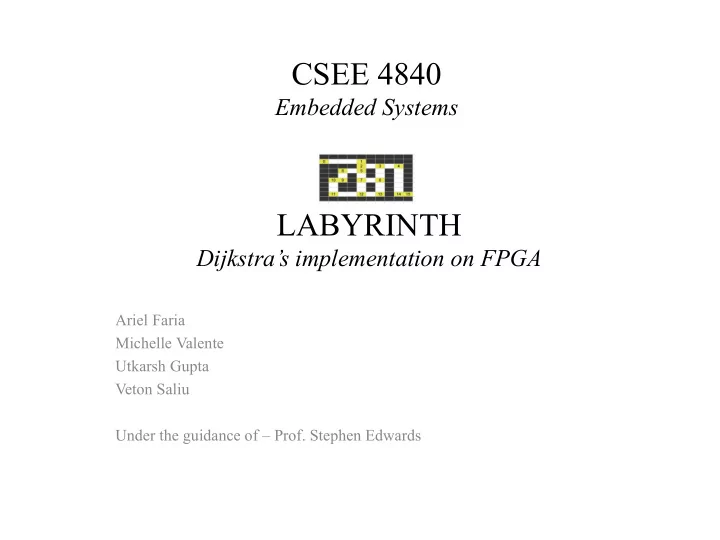

CSEE 4840 Embedded Systems LABYRINTH Dijkstra’s implementation on FPGA Ariel Faria Michelle Valente Utkarsh Gupta Veton Saliu Under the guidance of – Prof. Stephen Edwards
Overview and objectives • Single source shortest path • Dijkstra’s and properties • Sequential queues and growth • Advantages of Dijkstra’s on reconfigurable hardware and applications • In particular maze router – CAD APR • Implement the algorithm on FPGA and compute best path on hardware – Scale up to accommodate more nodes – Display the solved maze on the monitor – Benchmarking time
Dijkstra’s algorithm Cormen, Thomas H.; Leiserson, Charles E.; Rivest, Ronald L.; Stein, Clifford (2001). "Section 24.3: Dijkstra's algorithm". Introduction to Algorithms (Second ed.). MIT Press and McGraw-Hill. pp. 595 – 601. ISBN 0-262-03293-7.
Project Flow Software prototype Hardware Software driver Scale up and add-ons implementation • To understand the steps and • Software generates maze • Network display through constraints of the software • Translates to network • Designed basic network algorithms. • Implement for a 512 node • Communicates the network • Memory modules • Establish credibility for maze network to FPGA • Comparator blocks solving. • Hard wire 32 node network •Implemented Dijkstra’s
Software Prototypes • Two steps – Sequential, classic implementation – Using structures similar to hardware to confirm the correctness of parallel implementation
Hardware Implementations
Memory modules 10 bits 10 bits 512 lines 512 lines dist 1 dist 2 1 bit 10 bits 10 bits 512 lines visited 512 lines 512 lines prev 1 prev 2 15 bits 15 bits 15 bits 15 bits 512 lines 512 lines 512 lines 512 lines graph graph graph graph
Architecture (datapath) • Comparing • Updating Dist_u Compare dist1 dist2 perv1 perv2 sum dist1 dist1 Software dist1 graph num_node register
Minimum Distance Node Finder node index graph1 dist1 graph2 Compare index graph3 dist2 graph4
Software and Driver • Software spits out a random network • Sends this information in 32 bits to the FPGA • FPGA computes the minimum distance and displays on the monitor • Software sends the solved maze to the user monitor
Experiences and Issues • Monitor first, wrong approach SOLN: algorithm implementation • Maze size too big too ambitious SOLN: 32 node smaller network • Optimal structures for the memory modules for scaling up and parallel reads and stores • Algorithm – Comparing the neighbors but ended in dead end SOLN: Compare all nodes • Memory corruption SOLN: explicitly set values to reg in each state • Debugging and high compile time
Summary • Lessons learned – Not to violate setup or hold times by trying to fit heavy computation within a clock cycle; either make computations more efficient/ fast or allocate multiple clock cycles for the computation. – Allocating two dual port memory blocks to both the previous and distance data as opposed to allocating a separate module per node – There are two modules for scalability and efficient use of memory resources – Test the hardware after adding extra cycles of computation, makes it easier to debug and therefore reduces development time – We initially planned to compare all the distances but we found that that would be too costly in terms of the hardware we generated for a minor improvement in performance instead we decided to perform the comparison stage of the algorithm 4 nodes at a time on each clock cycle
Recommend
More recommend